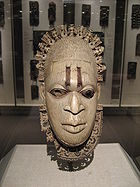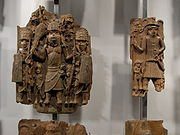
Benin art
Encyclopedia

Art
Art is the product or process of deliberately arranging items in a way that influences and affects one or more of the senses, emotions, and intellect....
from the Kingdom of Benin or Edo Empire (1440-1897), a pre-colonial African state located in what is now known as the South-South region of Nigeria
Nigeria
Nigeria , officially the Federal Republic of Nigeria, is a federal constitutional republic comprising 36 states and its Federal Capital Territory, Abuja. The country is located in West Africa and shares land borders with the Republic of Benin in the west, Chad and Cameroon in the east, and Niger in...
. Benin art was produced mainly for the court of the Oba of Benin
Oba of Benin
The Oba of Benin, or Omo N'Oba, is both the oba of the Edo people and the pretender to the defunct title of the king of the Benin Kingdom...
- a divine ruler for whom the craftsmen produced a range of ceremonially significant objects. Aside from producing work to promote theological and religious piety, Benin Art includes a range of animal heads, figurines, busts, plaques, and other artifacts. Typical Benin art materials include bronze, brass, clay, ivory, terracotta, and wood. During the reign of the Kingdom of Benin, the characteristics of the artwork shifted from thin castings and careful treatment to thick, less defined castings and generalized features. One of the objects unique to Benin art is an Ikegobo
Ikegobo
Ikegobo or "alters to the hand" is a type of cylindrical votive object from the Benin Empire. Used as a cultural marker of an individual's accomplishments, Ikegobo are dedicated to the hand, where the Beninese considered all will for wealth and success to originate from...
, a cylindrical object that celebrated the success of an individual.
Benin Art and Culture
Benin art has proven to be hard to interpret. This is due in part to the lack of supplementary written documents. Because of the non-literate nature of the ancient inhabitants of Benin City, there is a dearth in literary backup as would be seen in other cultures (Ben- Amos, 1980).A common consensus among historians is that the art of Benin served to narrate events and achievements, actual or mythical, which occurred in the past. It was grounded on traditional values and religious beliefs and displayed iconographic affinities. Although only made popular after the Punitive Expedition
Punitive expedition
A punitive expedition is a military journey undertaken to punish a state or any group of persons outside the borders of the punishing state. It is usually undertaken in response to perceived disobedient or morally wrong behavior, but may be also be a covered revenge...
in the 19th century, Benin art has been in existence since at least 500 BCE (Andrea & Overfield, 2005). They used their art to depict religious, social and cultural issues that were central to their beliefs such as ceremonial weapons, religious objects and masks (Blackmun, 1988). The culture of the Benin people was that of religious sentiment which can be seen in a lot of their art. They viewed their kings or obas as unearthly, in the sense that they were closer to the gods than the average human was. In a popular story, Ewuare, a ruler in the 15th and 16th century, goes to the river and steals the beads that belong to Olokun, god of the waters. He brings them back to Benin and in the process establishes the palace of the oba as the earthly counterpart and the kind of dry land (Ben- Amos, 1980). Stories and events like these inspired many of the beliefs and art of the early Benin people.
Economic Advantages and Disadvantages
The decline of Benin art occurred in the 19th century when the Punitive expedition by the British caused impairment in the creation of the arts. The peak of the art occurred in the fifteenth century with the arrival of the Portuguese missionaries and traders. Although the Portuguese met a militarily and economically developed city, their arrival catalyzed a process of even greater political and artistic development. Because of the Benin's military strength, the European visitors were for a while unable to make slaves of the people of Benin as they were in other cities in Africa. Instead, they established a trade whereby the Portuguese were able to offer military protection against enemies of Benin as well as luxury items that they needed. These items included coral beads, cloth and brass manilas for casting. In return, the Benin supplied them with pepper, cloth and their art work. Not many cities were as successful in preventing the sale of slaves and decline of their economy. Cities like Kongo, West Africa in the 16th century suffered because they found themselves manipulated by the European traders into situations whereby they were economically and militarily dependent on the sale of slaves. In “Letters to the King Portugal”, Alfonso I in his eagerness to develop his nation through European aid, falls prey to this economic tactic. The letters contain Alfonso’s complaints to the Portuguese king over the fact that the Portuguese traders were taking slaves at their whim. According to the letter, they were taking not only free men, but sons of noblemen as well. He explained that rather than trade, all he wanted from the Europeans were such things as education, health care and so on. His complaints fell on deaf ears and the people of Kongo could only watch helplessly because slave trade was the only thing they could offer in exchange for European support. The art of Benin was important because it prevented this kind of economic dependence. The relationship between the Portuguese and the Benin natives became more like an equal business deal than the unequal dominating relationship that can be seen with King Alfonso I.Portuguese Influence
As the trade flourished, the Portuguese influence on the art became apparent. Traditional art began to incorporate European imagery. For example, because the Portuguese sailed into Africa with luxury items, Benin artists began to associate them the Olokun, the god of seas and provider of earthly wealth. Images of the Portuguese sailors on bracelets, plaques or masks came with images associated with Olokun such as crocodiles and pythons. The brass plaque is also argued by historians to be a direct example of this Portuguese influence. There is indication that the first appearance of the brass plaque came about during the period of Portuguese contact. It is argued that the plaques were inspired by picture books brought to Africa by the Portuguese sailors. This is evident in the fact that certain plaques come with designs that suggest Islamic or European influence.Interpretations

The work pictured is a sixteenth century Benin Plaque. On the background can be seen the floral pattern that is characteristic of plaques made at this time. The patterns suggest Portuguese influence. The image in the plaque consists of an Oba
Oba of Benin
The Oba of Benin, or Omo N'Oba, is both the oba of the Edo people and the pretender to the defunct title of the king of the Benin Kingdom...
surrounded by his subjects. The oba is the largest image on the plaque. As traditions go, the oba and rulers are viewed as larger than mortal men. This attitude can be seen in the artist’s depiction of the oba. He is attired in full war garments that suggest the importance of possessing military/warrior strength. The staff he holds in his hand also shows his power and divinity among his people. Apart from military and political strength, the plaque shows the relationship between the Portuguese and the Benin traders. The oba’s subjects are depicted carrying bent iron bar, a ceremonial sword and musical instrument. These are artworks made by the Benin artists and are used as trading items. Behind the oba in the plaque, are the Portuguese traders. Europeans at this time were popularly depicted with rounded hats, shoulder-length hair and short beards, as can be seen in the plaque. In their hands, they carry what looks like a mirror and a goblet. These represent the luxuries that the Portuguese brought with them as they sailed to Benin. The plaque is a good example of the trade that existed between the Portuguese and native Benin inhabitants.
Another example can be seen in the Benin-Portuguese salt cellar. This artwork shows further the influence of the Portuguese on Benin. The salt cellar shows Portuguese officials and their assistances. Although the figures are Portuguese, they are depicted much like Benin rulers. The figure in the front is wearing a cross which can be seen as showing the mercenary intentions of the Portuguese. They came not only for trade but to convert the Africans to Christianity. The person is also wearing a crown and is holding a staff and a ceremonial sword which is said to have been the ruler, Esigie’s way of showing approval of an oba’s coronation (Ben- Amos, 1980). The fact that the figure is wearing these items shows the power that the people of Benin associated with the Portuguese. The ship in the figure also shows the means of transportation with which they arrived in Benin. This also reinforces the sense of power as it showed the associated with the river god, Olokun. These examples of art show the attitudes of the people as well as their traditions and beliefs. They are important because of the lack of literary work that can be found among other cultures. They guide in the historian's understanding of the ideas and feelings that came with the art.

